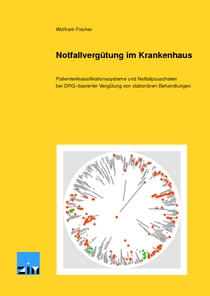| |
Abstract (English) |
1 |
| |
|
|
Introduction |
Flat rates based on Diagnosis Related Groups (DRGs) are being introduced
in a growing number of countries
to remunerate acute inpatient treatment.
In doing so, it will have to be decided – among other things –
whether inpatient emergency services should be remunerated
separately from the DRG flat rates or as part of them.
Without separate remuneration,
there may be an apprehension
that wrong economic incentives
with regard to emergency services
could develop.
To be able to decide
about a separate remuneration of emergency readiness
and/or emergency treatment
one must know
how to categorise services,
what are the costs of emergencies
and how the remuneration can be deduced from them. |
2 |
Method |
By means of internet searches,
the author describes different solutions
of emergency patient classification systems
and emergency flat rates
in France, United Kingdom,
and New South Wales (Australia).
Additionally, he shows various approaches towards
regulations in Switzerland,
Germany, United States, Canada, and Victoria (Australia).
Out of the information collected (reference year 2008),
he draws up suggestions with a view to deciding whether
any increased emergency costs would justify separate remuneration
and how this could be set up. |
3 |
Investigation results:
– France |
In France,
an annual lump sum based on the size of the emergency ward/department
is paid to remunerate emergency readiness.
(The size of the emergency ward is calculated on the basis of
the budgeted number of emergency attendances.)
Emergency admissions (emergencies with subsequent inpatient admission)
are paid through GHS flat rates
(GHS = "Groupes homogènes de séjours" = French DRG flat rates).
Outpatient emergency attendances are paid at a flat rate of € 25. |
4 |
– United Kingdom |
In the United Kingdom,
different HRG flat rates
are defined
for elective and non-elective cases
(HRGs = Healthcare Resource Groups = British DRGs).
In this way, about 10 % of the total remuneration volume
are redistributed.
(Non-elective cases encompass not only emergencies but also
births, newborns, and transfers.)
Additionally, there is a three-tier emergency tariff
to remunerate for inpatient and outpatient emergency attendances.
It is defined by means of about 10 emergency HRGs.
80 % of the emergency tariff is paid on the basis of the planned
emergency attendances in order to cover emergency readiness.
This is done regardless of the actual number of emergency attendances
("80/20 rule").
These emergency flat rates are paid for emergency admissions
in addition to the non-elective HRG flat rate.
50 % of the latter are paid on the basis of the planned number of
emergency admissions,
and 50 % as per actual admissions ("differential tariff"). |
5 |
– New South Wales |
In New South Wales (Australia),
emergency services are categorized into seven levels
according to their roles and staffing.
80 % of emergency costs (for inpatient and outpatient cases)
are paid by a budget for emergency readiness.
To this end, the planned cases are weighted by means of
emergency patient classification system
UDG ("Urgency and Disposition Groups")
which defines 11 patient categories.
Three base rates are used according to the types of hospital.
(The three types of hospital are:
"general referral hospitals"
or "large metropolitan districts";
"childrens";
"small metro districts" or "rural base".)
The remaining 20 % of emergency costs are paid
by UDG weighted emergency flat rates.
For emergency admissions,
an ARDRG flat rate is paid additionally. |
6 |
– Switzerland |
In Switzerland, acute inpatient treatment will be remunerated
from 2012 onward
by the SwissDRG-System, an adapted GDRG-System.
Following a law introduced at the end of 2007,
the new flat rates must not contain public welfare services.
Hence, emergency readiness has to be calculated and remunerated
separately from DRG flat rates, independently of the number of cases. |
7 |
– Germany |
In Germany,
there is no separate remuneration for emergency admissions.
In principle, hospitals are ordered to participate in emergency services.
Hospitals which do not participate have to
expect a deduction of € 50 per case. |
8 |
Suggestions |
The main suggestions which were deduced from several others, are:
(1)
Emergency readiness should be defined and remunerated
by performance contracts.
A bonus system could promote the attainment of certain emergency targets.
(2)
To be able to assess the costs of emergency treatment,
all DRGs should be split as per the criterion "with/without
emergency attendance".
The concept of "emergency attendance" must therefore be defined.
A medical definition would be:
"Emergency attendances are attendances of patients
who are required to be treated within x (e. g. 12) hours."
If cost differences arise,
these can be taken into account by applying separate DRG weights
for DRGs "with emergency attendance"
and DRGs "without emergency attendance". |
9 |
 fulltext
(1.9 MB)
fulltext
(1.9 MB) Notfallvergütung im Krankenhaus (Zusammenfassung)
Notfallvergütung im Krankenhaus (Zusammenfassung) Remboursement des urgences hospitalières (Résumé)
Remboursement des urgences hospitalières (Résumé)